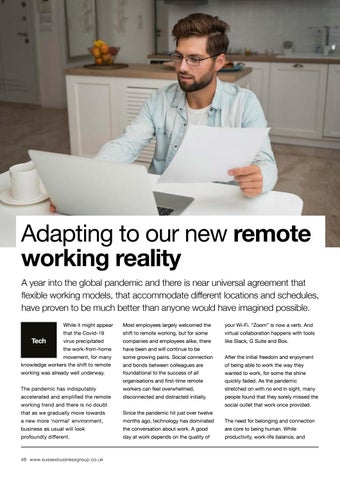Adapting to our new remote working reality
A year into the global pandemic and there is near universal agreement that flexible working models, that accommodate different locations and schedules, have proven to be much better than anyone would have imagined possible. While it might appear
Tech
that the Covid-19 virus precipitated
the work-from-home
movement, for many
knowledge workers the shift to remote working was already well underway. The pandemic has indisputably
accelerated and amplified the remote working trend and there is no doubt that as we gradually move towards a new more ‘normal’ environment, business as usual will look profoundly different.
48 www.sussexbusinessgroup.co.uk
Most employees largely welcomed the shift to remote working, but for some
companies and employees alike, there have been and will continue to be
some growing pains. Social connection and bonds between colleagues are foundational to the success of all
organisations and first-time remote workers can feel overwhelmed,
disconnected and distracted initially. Since the pandemic hit just over twelve
months ago, technology has dominated the conversation about work. A good
day at work depends on the quality of
your Wi-Fi. “Zoom” is now a verb. And
virtual collaboration happens with tools like Slack, G Suite and Box.
After the initial freedom and enjoyment of being able to work the way they
wanted to work, for some the shine quickly faded. As the pandemic
stretched on with no end in sight, many
people found that they sorely missed the social outlet that work once provided.
The need for belonging and connection are core to being human. While
productivity, work-life balance, and



